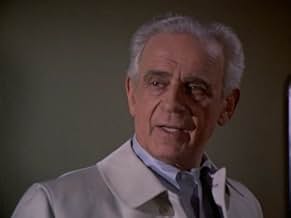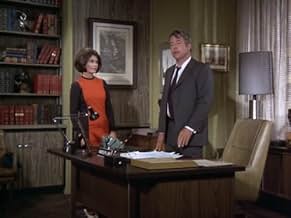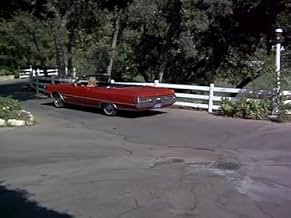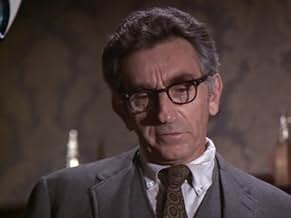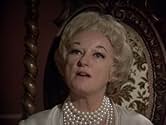IMDb-BEWERTUNG
7,9/10
6586
IHRE BEWERTUNG
Rod Serling präsentiert Horrorgeschichten, die in verschiedenen Gemälden illustriert sind.Rod Serling präsentiert Horrorgeschichten, die in verschiedenen Gemälden illustriert sind.Rod Serling präsentiert Horrorgeschichten, die in verschiedenen Gemälden illustriert sind.
- Für 2 Primetime Emmys nominiert
- 2 Gewinne & 4 Nominierungen insgesamt
Folgen durchsuchen
Empfohlene Bewertungen
There is something that sets Night Gallery apart from all other sci-fi/thriller TV shows. An ethereal element of mystique lurks within every episode that provides for unique entertainment. Narrated by Rod Serling, Night Gallery explores the supernatural from the context of an abstract painting--a different painting each episode. When narrating his previous series, The Twilight Zone, Serling generally manifested an air of superiority to the plot--like he had it in the palm of his hand and could control it. In Night Gallery, however, he relinquishes such control and becomes more a PART of the madness; as if the gallery is controlling HIM (it is also refreshing to finally view him in color). Night Gallery episodes are NOT concluded with a Serling anecdotal summary; instead, a shocking punch is usually delivered that the viewer is left to unravel without assistance.
The directing and editing are top notch. Scenes cascade in a swift and somewhat ambiguous fashion, and camera tricks are cleverly exploited to hold our attention--proving that today's computer graphics are not essential to exact viewer interest. Simple story lines are translated into convoluted journeys of intrigue with music and sound effects akin only to The Exorcist.
Some memorable episodes include Sally Field playing a woman with multiple personalities (this was before she played Cybil, mind you); an ostracized young girl who befriends a seaweed monster; a diner jukebox that hauntingly plays only one song; a man who has an earwig planted in his ear that creeps through his brain (and lays eggs!); and a young Clint Howard (Ron's kid brother) playing a child prodigy who foresees mankind's treacherous fate.
Of course, there are those little, campy vignettes thrown in for fun, most of which are mildly amusing. Overall, this is an exhibit you will not want to bypass!
The directing and editing are top notch. Scenes cascade in a swift and somewhat ambiguous fashion, and camera tricks are cleverly exploited to hold our attention--proving that today's computer graphics are not essential to exact viewer interest. Simple story lines are translated into convoluted journeys of intrigue with music and sound effects akin only to The Exorcist.
Some memorable episodes include Sally Field playing a woman with multiple personalities (this was before she played Cybil, mind you); an ostracized young girl who befriends a seaweed monster; a diner jukebox that hauntingly plays only one song; a man who has an earwig planted in his ear that creeps through his brain (and lays eggs!); and a young Clint Howard (Ron's kid brother) playing a child prodigy who foresees mankind's treacherous fate.
Of course, there are those little, campy vignettes thrown in for fun, most of which are mildly amusing. Overall, this is an exhibit you will not want to bypass!
I grew up watching this as a really little kid in Brooklyn, my family loved this show and it's probably the reason I still suffer from Night Terrors to this DAY! I was 5 when I saw 1971 episode THE DOLL. (there are 2 different doll episodes, I think the other is from 73 and is called Doll of Death)
Anyhoo, I was SO FREAKED out from watching that 71 The Doll episode that I still remember having horrible nightmares as a kid and I called the Episode The Doll with the Black Eyes. I couldn't sleep in a room with dolls, and I had a new strange raggedy ann type doll my aunt had just bought me, and she had Solid Black Eyes. I loved that doll, but could not sleep with it in my bed or anywhere in my room at night after this episode. I would make my Mom lock it up every night. Seriously!! I Never wanted to re-watch that episode growing up and even as an adult cannot sleep in any room with dolls. I finally re-watched this in 2004, I'm a grown woman and YES, it still CREEPED ME OUT!! It's like this episode gave me PTSD as a kid, and all those feelings of Terror came flooding back. I know, it sounds crazy, but it's TRUE! I haven't watched it since. LOL I'm creeped out just writing this and remembering how terrorized I felt as a child. Rod Serling was Great and I love him to this day, but his show Freaked me out and left my sleep disturbed to this day. But weird thing is I always Loved Horror Movies and can watch The Walking Dead alone at night with no problems, but Don't play the Doll with the Black Eyes for me, cause I don't think I will sleep for days. :o Great old school series with alot of creepy and disturbing episodes. ;D.
Rod Serlings follow up to Twilight Zone. This series originally began as a four in one alternating with three other shows and each would get one airing per month. Night Gallery was easily the best and became a weekly. While Twilight Zone dealt with Science Fiction Gallery dealt on the macabre horror side. Rod as host would introduce each story via a painting.
A few (mostly the short ones) had tongue in cheek humor. The others could be very spooky. The theme music was equally eerie. The show now airs on the Sci-Fi channel. Having watched it when it originally aired it seems that the episodes are edited here and there. Later episodes were added from another series entitled The Sixth Sense and they were not nearly as good as the Serling ones.
A few (mostly the short ones) had tongue in cheek humor. The others could be very spooky. The theme music was equally eerie. The show now airs on the Sci-Fi channel. Having watched it when it originally aired it seems that the episodes are edited here and there. Later episodes were added from another series entitled The Sixth Sense and they were not nearly as good as the Serling ones.
The Night Gallery was Rod Serling introducing tales of terror and irony much like he did for the Twilight Zone. While the TZ dealt more with Sci-Fi, Night Gallery dealt with the macabe. Damn, was it good and scary. The stories that stood out in my mind were the Tune In Dan's Cafe, Green Fingers and They're Aren't Anymore McBanes. Talk about scary. I remember watching the McBanes episode and it scared the daylights out of me and my mother who was watching it with me. The TUne in Dan's Cafe is very haunting. To me this is one of the best anthology shows ever, ranking up there with the Outer Limits(the original) Tales From the Darkside, One Step Beyond, and the great Twilight Zone. I love the fact that the Sci-Fi channel runs Twilight Zone episodes back to back in front of the older Outer Limits episodes. Now if only it would add the Night Gallery all would be perfect in the afternoon. The Night Gallery is classic horror anthologies at their best. Great acting, great stories, scary as hell. Pass the popcorn and get ready for some real chills. way to go Rod Serling another classic show.
One of the most underrated TV series of the 1970s, and of all time, is this terrific collection of sci-fi and horror stories, hosted by Rod Serling. Often (wrongly) compared to Serling's other series, "The Twilight Zone"...the overall mood, and purpose of this series is different. The "Zone" was a collection of morality tales, disguised as sci-fi stories. A fantastic show, without a doubt, but the "Gallery" was designed purely to shock and entertain...and it certainly succeeded in that area.
So much great talent was on display in this series. The actors, writers, directors, and musicians were almost always top-notch. Though the decision to have multiple stories within each episode, did result in some mediocre results sometimes (especially with the campy vignettes), the quality of the better segments is what most remember best.
Among some of the better segments:
"They're Tearing Down Tim Riley's Bar", with William Windom (in an awesome performance) as a has-been salesman who's beckoned by the ghosts of his past.
"The Doll", about a gruesome doll, sent to a British officer as revenge.
"The Tune in Dan's Cafe", about a haunted jukebox that plays the same song always.
"Green Fingers", with Elsa Lanchester as an elderly woman, harassed by a tycoon who wants her land, where she has an unusual knack for gardening.
So many more great ones. Some folks get turned off by the dated 1970s look to this show (the costumes, sets, bright color, excessive use of zooms/close-ups). If you can get past that aspect, and rather appreciate the show's camp value, you're sure to enjoy this unique and highly original horror series. It's a classic in my book.
So much great talent was on display in this series. The actors, writers, directors, and musicians were almost always top-notch. Though the decision to have multiple stories within each episode, did result in some mediocre results sometimes (especially with the campy vignettes), the quality of the better segments is what most remember best.
Among some of the better segments:
"They're Tearing Down Tim Riley's Bar", with William Windom (in an awesome performance) as a has-been salesman who's beckoned by the ghosts of his past.
"The Doll", about a gruesome doll, sent to a British officer as revenge.
"The Tune in Dan's Cafe", about a haunted jukebox that plays the same song always.
"Green Fingers", with Elsa Lanchester as an elderly woman, harassed by a tycoon who wants her land, where she has an unusual knack for gardening.
So many more great ones. Some folks get turned off by the dated 1970s look to this show (the costumes, sets, bright color, excessive use of zooms/close-ups). If you can get past that aspect, and rather appreciate the show's camp value, you're sure to enjoy this unique and highly original horror series. It's a classic in my book.
Wusstest du schon
- WissenswertesArtist Thomas J. Wright painted all of the paintings used to introduce each story.
- Zitate
Rod Serling: For those of you who've never met me, you might call me the under-nourished Alfred Hitchcock.
- Alternative VersionenMajor changes were made to most episodes for syndication. The 60-minute episodes were edited down to 30 minute packages, with major edits to some of the 30-40 minute segments of the original shows. In cases of segments that were only 15-20 minutes in length, these were padded out by adding stock footage, newly shot scenes, and footage from Hollywood movies such as Lautlos im Weltraum (1972) and Fahrenheit 451 (1966). Most musical cues were also replaced for syndication. In order to augment "Night Gallery"'s syndicated run, episodes of The Sixth Sense (1972) were edited down to 30 minutes, had new introductions by Rod Serling tacked on, and were added to the syndicated run of "Night Gallery."
- VerbindungenEdited from Four-In-One (1970)
Top-Auswahl
Melde dich zum Bewerten an und greife auf die Watchlist für personalisierte Empfehlungen zu.
- How many seasons does Night Gallery have?Powered by Alexa
Details
- Erscheinungsdatum
- Herkunftsland
- Sprache
- Auch bekannt als
- Night Gallery
- Drehorte
- Produktionsfirma
- Weitere beteiligte Unternehmen bei IMDbPro anzeigen
- Laufzeit50 Minuten
- Sound-Mix
- Seitenverhältnis
- 1.33 : 1
Zu dieser Seite beitragen
Bearbeitung vorschlagen oder fehlenden Inhalt hinzufügen

Oberste Lücke
By what name was Wo alle Wege enden (1969) officially released in India in English?
Antwort

